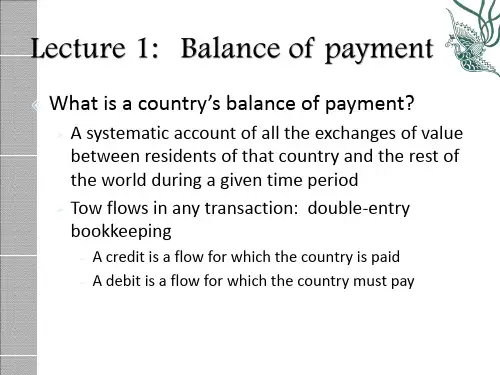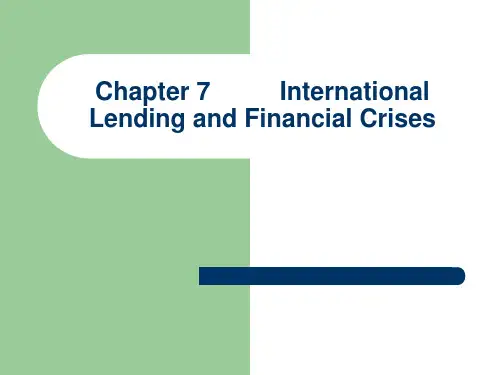国际金融英文版(托马斯A普格尔著)---Chapter7
- 格式:ppt
- 大小:296.00 KB
- 文档页数:35
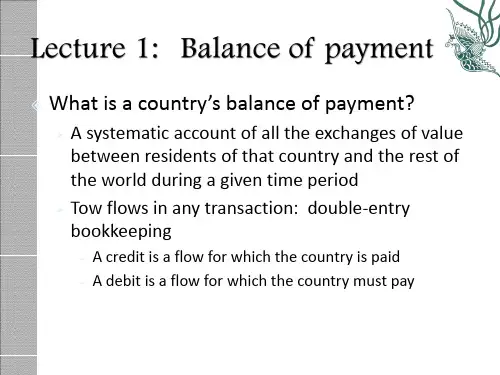
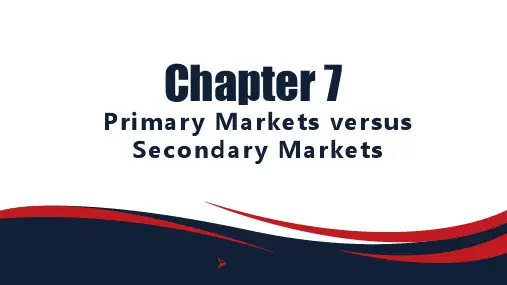

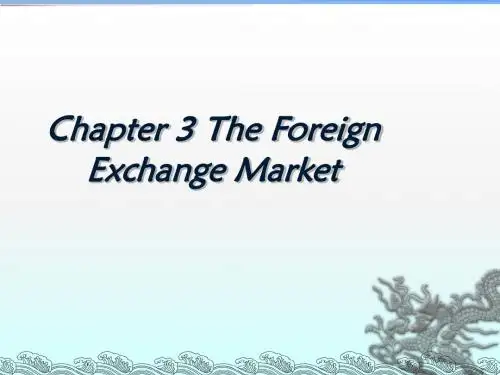
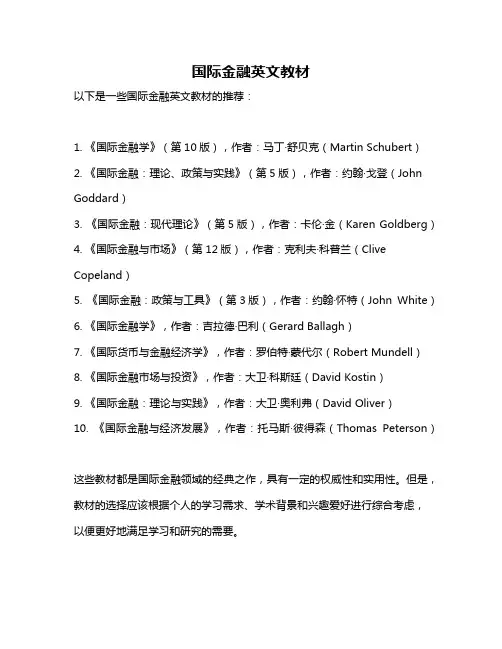
国际金融英文教材
以下是一些国际金融英文教材的推荐:
1. 《国际金融学》(第10版),作者:马丁·舒贝克(Martin Schubert)
2. 《国际金融:理论、政策与实践》(第5版),作者:约翰·戈登(John Goddard)
3. 《国际金融:现代理论》(第5版),作者:卡伦·金(Karen Goldberg)
4. 《国际金融与市场》(第12版),作者:克利夫·科普兰(Clive Copeland)
5. 《国际金融:政策与工具》(第3版),作者:约翰·怀特(John White)
6. 《国际金融学》,作者:吉拉德·巴利(Gerard Ballagh)
7. 《国际货币与金融经济学》,作者:罗伯特·蒙代尔(Robert Mundell)
8. 《国际金融市场与投资》,作者:大卫·科斯廷(David Kostin)
9. 《国际金融:理论与实践》,作者:大卫·奥利弗(David Oliver)
10. 《国际金融与经济发展》,作者:托马斯·彼得森(Thomas Peterson)
这些教材都是国际金融领域的经典之作,具有一定的权威性和实用性。
但是,教材的选择应该根据个人的学习需求、学术背景和兴趣爱好进行综合考虑,以便更好地满足学习和研究的需要。
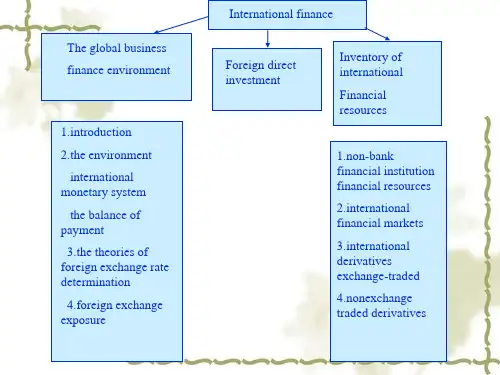
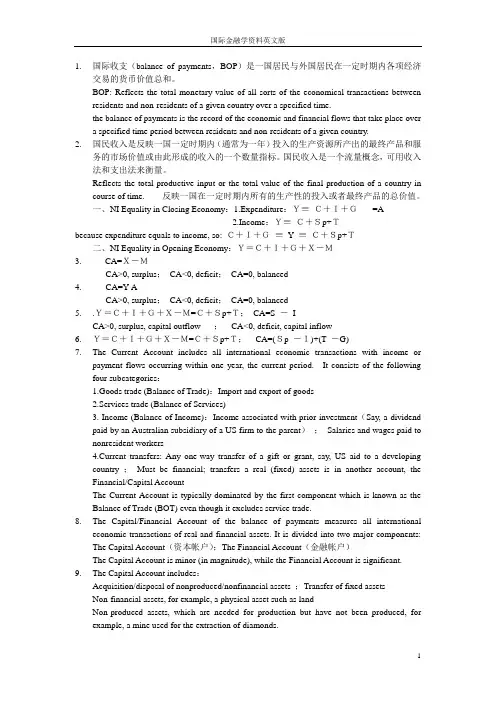
1.国际收支(balance of payments,BOP)是一国居民与外国居民在一定时期内各项经济交易的货币价值总和。
BOP: Reflects the total monetary value of all sorts of the economical transactions between residents and non-residents of a given country over a specified time.the balance of payments is the record of the economic and financial flows that take place overa specified time period between residents and non-residents of a given country.2.国民收入是反映一国一定时期内(通常为一年)投入的生产资源所产出的最终产品和服务的市场价值或由此形成的收入的一个数量指标。
国民收入是一个流量概念,可用收入法和支出法来衡量。
Reflects the total productive input or the total value of the final production of a country in course of time. 反映一国在一定时期内所有的生产性的投入或者最终产品的总价值。
一、NI Equality in Closing Economy:1.Expenditure:Y≡C+I+G=A2.Income:Y≡C+Sp+Tbecause expenditure equals to income, so: C+I+G≡Y ≡C+Sp+T二、NI Equality in Opening Economy:Y=C+I+G+X-M3.CA=X-MCA>0, surplus;CA<0, deficit;CA=0, balanced4.CA=Y-ACA>0, surplus;CA<0, deficit;CA=0, balanced5..Y=C+I+G+X-M=C+Sp+T;CA=S -ICA>0, surplus, capital outflow ;CA<0, deficit, capital inflow6.Y=C+I+G+X-M=C+Sp+T;CA=(Sp -I)+(T -G)7.The Current Account includes all international economic transactions with income orpayment flows occurring within one year, the current period. It consists of the following four subcategories:1.Goods trade (Balance of Trade):Import and export of goods2.Services trade (Balance of Services)3. Income (Balance of Income):Income associated with prior investment(Say, a dividendpaid by an Australian subsidiary of a US firm to the parent);Salaries and wages paid to nonresident workers4.Current transfers: Any one-way transfer of a gift or grant, say, US aid to a developingcountry ;Must be financial; transfers a real (fixed) assets is in another account, the Financial/Capital AccountThe Current Account is typically dominated by the first component which is known as the Balance of Trade (BOT) even though it excludes service trade.8.The Capital/Financial Account of the balance of payments measures all internationaleconomic transactions of real and financial assets. It is divided into two major components: The Capital Account(资本帐户);The Financial Account(金融帐户)The Capital Account is minor (in magnitude), while the Financial Account is significant.9.The Capital Account includes:Acquisition/disposal of nonproduced/nonfinancial assets ;Transfer of fixed assetsNon-financial assets, for example, a physical asset such as landNon-produced assets, which are needed for production but have not been produced, for example, a mine used for the extraction of diamonds.10.The Financial Account, however, uses a third method. This focuses on the degree ofinvestor control over the assets or operations.The Financial Account consists of three components;Direct Investment –in which the investor exerts some explicit degree of control over the assets(直接投资)Portfolio Investment – in which the investor has no control over the assets(证券投资)Other Investment –consists of various short-term and long-term trade credits, cross-border loans, currency deposits, bank deposits and other A/R and A/P related to cross-border trade (其他投资)11.12.The Official Reserves Account is the total reserves held by official monetary authoritieswithin the country.These reserves are normally composed of the major currencies used in international trade and financial transactions (hard currencies).The significance of official reserves depends generally on whether the country is operating under a fixed exchange rate regime or a floating exchange rate systemUnder a fixed exchange regime, these reserves are important in defending the value of a depreciating currencyChanges in the official reserves represents cash in- or outflows that are capture in the Official Reserves AccountThe Net Errors and Omissions account ensures that the BOP actually balances due to measurement errorsThe errors and omissions in balance of payments accounting arise in large part from the statistical difficulties involved in gathering balance of payments data. Because officials do not have the necessary information to make the double entries they make single entries based on the information available to them. This information often comes from multiple sources that vary in coverage and reliability.13.Reserves include monetary gold, special drawing rights (SDRs), the reserve position in theFund and foreign exchange.14.Fundamentals of BOP Accounting:Credits: real resources exported ------ Positive SignDebits: real resources imported ------ Negative SignTwo empirical rules:All transactions that arouses foreign exchange income should be credited in BOP;All transactions that arouses foreign exchange expenditure should be debited in BOP.Autonomous Transaction:- credit > debit, surplus; - credit < debit, deficit.Accommodating Transaction: - credit > debit, deficit; - credit < debit, surplus.15.X –M = the current account balance16.In theory the BOP must always balance, but statistical errors and misreporting result insubstantial imbalances17.The net errors and omissions account ensures that the BOP actually balances due tomeasurement errors18.Foreign Exchange:Dynamic usage: International exchange transaction in market for shortStatic usage: It means the money of a foreign country and includes:Foreign currency bank balances;Banknotes;Checks and drafts;Currency19. A foreign exchange transaction is an agreement between a buyer and a seller that a fixedamount of one currency will be delivered for some other currency at a specified date20.The spot where handles goods is goods market, while the place where deals ForeignExchange is Foreign Exchange Market.21.Functions of the Foreign Exchange Market:Permit the transfer of purchasing power denominated in one currency into another currency and thereby facilitate transactions;Provide credit for international trade transactions;Minimize exposure to the risks of exchange rate changes22.Speculators and Arbitrageurs:Speculators and arbitrageurs seek to profit from trading in the market itself, not for conducting trade or other forms of businessThey operate in their own interest, without a need or obligation to serve clients or ensure a continuous marketSpeculators seek to profit from their view of exchange rate changesArbitrageurs seek to profit from simultaneous exchange rate differences in different markets23. A foreign exchange rate is the price of one currency expressed in terms of another currencyA foreign exchange quotation (or quote) is a statement of willingness to buy or sell at an announced rate.24. A direct quote is a home currency price of a unit of foreign currency ;An indirect quote is a foreign currency price of a unit of home currencyThe form of the quote depends on what the speaker regards as “home ”25. Measuring a change —depreciation of appreciation of a foreign currency —in the spot rate forquotations expressed in home currency terms:Direct quotations:Example: Suppose the Swiss franc is recently quoted in the spot market at SF1.5625/$ (or, equivalently, $0.6400/SF) but then suddenly appreciates to SF1.2800/$ (or, equivalently, $0.78125/SF). What is the percent appreciation of the SF relative to the dollar?26. Measuring a change —depreciation of appreciation of a foreign currency —in the spot rate forquotations expressed in foreign currency terms:Indirect quotations: All our formulas have been in Indirect terms with the US$ as the home currencyExample (continued): The same rate of appreciation for the Swiss Franc relative to the US Dollar! 27.Spot rate: adopt a Spot transaction ;Forward rate: adopt a forward transaction 28.A Spot transaction in the Interbank market is the purchase of foreign exchange with delivery and payment between banks to take place, normally, on the second following business day. The date of settlement is referred to as the value date. 29.An Outright Forward transaction (usually just called a Forward) requires delivery at a future date of a specified amount of one currency for a specified amount of another currency. The exchange rate is established at the time of the agreement, but payment and delivery are not required until maturity. Forward exchange rates are usually quoted for value dates of one, two, three, six and twelve months. 30. Arbitrage :seek to profit from simultaneous exchange rate differences in different marketsDirect arbitrage: operate between two foreign marketsIndirect arbitrage: operate in three foreign marketsInterest Arbitrage: seek to profit from simultaneous interest rate differences in different marketsClass Drill 1:1、Assumption:the basic rate between US dollars and the RMB is normally stated: $1=¥8.2500, the basic rate between US dollars and the J ¥ is normally stated: $1=J ¥100.0000Calculation: what ’s the cross rate between RMB and J ¥ ?2、Assumption:%07.22/6400.0$/6400.0$/78125.0$+=-SFSF SF%07.22$/2800.1$/2800.1$/5625.1+=-SF SF SFone day, an American exporter dates a contract with a Germany importer for some goods worthy of DM1,500,000. The counting currency is DM. They will pay off after three months. The rate is $1=DM1.5000 when they signed the treaty.Questions:- What does the rate belong to when they are dating?-Which country wouldn’t suffer the risk of foreign exchange?-How to avoid it?3、Assumption:One day------ first day in May, a speculator anticipates the exchange rate between US dollar and DM is $1=DM1.4580 on first day in Augest, while the three-month exchange rate between US dollar and DM is stated $1=DM1.4500 on first day in Augest.Questions:-What’s the former rate and latter rate respectively?-How can get the profit?4、Assumption:At 10 am. on one business day, the exchange rate between US dollar and DM is stated $1=DM1.4500 in New York, while simultaneously the exchange rate between US dollar and DM is stated $1=DM1.4600 in Frankfurt.Questions: How to arbitrage?5、Assumption:At 10 am. on one business day, the exchange rate between US dollar and DM is stated $1=DM1.5100 in New York, simultaneously the exchange rate between Pound and DM is stated £1 =DM3.0000 in Frankfurt, while the exchange rate between Pound and US dollar is stated £1 =$2.8000 in London.Questions: How to arbitrage?6、Assumption:The one-year periodic interest rate of US dollar in U.S is 12%, while the one-year periodic interest rate of UK pound in U.S is 16%. £1=$2.0000, $1,000,000Questions:-If the exchange rate between US dollar and UK pound is fixed after 3 months, how to invest?-If the exchange rate between US dollar and UK pound is floating after 3 months, how to invest?31.The Typical Dynamics of a Currency Crisis:1.Currency crises begin with foreign investors or speculators deciding—for whatever reason—that at the pegged rate, the country’s currency is overvalued;2.Foreign investors respond by selling their real and financial assets in the country, hence,selling that countries currency;ernments sell their foreign reserves and buy their own currency to defend the peg;Speculators observe the declining foreign reserves and increase their short positions in the country’s financial assets or currency;4.Panic selling ensues;5.The government abandons the peg and devalues the currency—typically by more thanwould have been required at earlier stages of the crisis32.Currency Crises: Effects of Devaluation:1.Real prices for imports rise;2.Output falls:Production (aggregate supply) falls when the economy relies heavily on imported inputs, for example, oil;Consumption (aggregate demand) falls when the country relies heavily on imports for necessities such as food stuffs. (Higher prices for necessities means lower disposable income)3. The net worth of firms and individuals fall4.The banking system is severely weakened (details):Assets (denominated in the home currency) lose value relative to debt (often denominated ina foreign currency in emerging economies);Credit is either rationed or available only at exorbitant rates;Lack of credit causes output to plummet even further!33.Contagion: It is formally defined as a situation in which a currency crisis in one countryincreases the probability of a currency crisis in another34.Hedge funds are unregulated investment institutions that specialize in short selling, use offinancial derivatives, and leveraged positions (purchasing assets with borrowed funds):Despite the name, hedge funds speculate!The primary investors are pension funds, trust funds, university endowments, and accredited investorsThese funds tend to remain fairly liquid so that they can fully exploit profit opportunities when they ariseHedge funds have about $1.1 trillion in assets and account for one half of all trades in the US and UK stock markets35.Role of Hedge Funds:The focus of hedge funds on short selling has gained them much notoriety as they often do well when asset prices are falling and other funds are doing badly;Prime Minister Mahathir Mohamad of Indonesia has called hedge funds the “highwaymen of the global economy”;Why? Because of robbing from the poor, less developed and emerging economies where hedge funds do much of their business;In fact, hedge funds have been blamed for not just taking advantage of economic crises but for causing them!Summary:1.Capital mobility is a double-edged sword: Economic openness increases growth andefficiency, but also exposes economies to potential capital outflows that can destabilize the economy2.A currency crisis is a financial crash within the foreign exchange markets. Currency crisesare precipitated by :Capital flight, that is, a large and rapid withdrawal of funds by foreign investors ;Speculative attack3.Currency crises are caused by:Correlated beliefs among international investors (self-fulfilling prophesies);Poor economic fundamentals:A fragile and inefficient banking system;Inflationary monetary and fiscal policy4. The central bank responds to a currency crisis by devaluing the country’s currency. Theeffects on the economy are devastating:Real prices for imports rise;Output and consumption fall;The net worth of firms and individuals fall;Unemployment and poverty escalate;The banking system is severely weakened and credit intermediation nearly ceases5. Contagion is caused by:Correlated real shocks, trade linkages, and financial linkages;Correlated beliefs, herding, or wake-up calls6、Currency crises and contagion have become increasingly likely and increasingly severesince the 1990s due, largely, to a far greater level of international economic integration and capital mobility in particular7.Policies prescriptions that reduce the likelihood of a currency crisis and contagion are:Promote the soundness of the financial system—particularly banks;Balance budgets and conduct low inflation monetary policy;Implement short-term capital controls and establish a lender of last resort;Promote long-term—as opposed to hot money—investment;8.Emerging market countries must often choose between two extreme exchange rate regimes,either free-floating or fixed regime where the latter is often through a currency board or dollarization36.Goods market equilibrium in opening economyAssumption:Output is defined by demand totally.BOP refers to import and export of merchandise.One country only produce one product.Nominal variable and real variable.37.Trade balance and national incomeTN =XN – MN =PM* –eP*M ;T=TN /P =M* –(eP*/P) M=M *–qMTrade balance function:T= M*(q,Y*)- qM(q,Y)=T(q,Y*,Y)=T-mY-T: independent trade balance;-mY: dependent trade balance;-m: marginal import tendency38.Domestic absorb and national income:A=C+I+G(Domestic absorb )C=C+aY -C: independent consumption;-aY: dependent consumption;-a: marginal consumption tendency A=G+I+C=G+I+C+aY=A+aY39.Hoard: H=Y-A H=Y-A=Y-(A+aY)=-A+(1-a)Y=-A+sY -s: marginal saving tendency40.The equilibrium of national income :H=T;H=-A+sY=T-mY=T;Y=(A+T)/(s+m)= (A+T)41.Goods market, currency market and foreign exchange market in opening economyAssumption:Output is defined by demand totally.BOP refers to import and export of merchandise.One country only produce one product.1. IS curve :It reflects equilibrium condition in goods market.For private investment: I =I (i )=I0-biFor domestic absorb: A =A (G ,i ,Y )=A +aY -biIn what condition, goods market would be balance?Y=A +T =A+aY-bi+T0-mY ; Y=a (A-bi+T0) ; a=1/(1+m-a )Economic analysis :The slope is minus ;In what condition, the curve would move towards right? If I descends, in which condition (open economy & close economy) national income would increase more?2. LM curve :It reflects equilibrium condition in currency market.Ms=Md; Ms/P=LD (i ,Y )=kY-hi k>0,h>0) Y=1/k(hi+M0/P)3. CA curve: It reflects equilibrium condition in foreign exchange market .T=T-mY=0 Y=T/mThe equilibrium is irrelevant to i.For CA curve, Left------ surplus, Right------ deficitWhen it satisfies the Marshall- Lerner condition,q ,the curve moves towards right; q ,the curve moves towards left.42. Open economy equilibrium in fixed exchange system (equilibrium condition):1、如左图:In closing economy: equilibrium in both markets (goods market & currency market) A point2、如右图:In opening economy:equilibrium in three markets(goods market, currency market and foreign exchange market) A ’ point3、如左图:Income mechanism (short term):Deficit in BOP(CA):Decrease in foreign exchange ; reserve ; Decline in currency supply ; Descend in national income ;Dip in import expenditure ; Improve in CAi 0i 04、如右图:Currency-price mechanism (long term):Deficit in BOP(CA): Decrease in foreign exchange ; reserve ; Decline in currency supply ; Descend in Price level ;Devaluation in real exchange ; Improve in CA 43. Open economy equilibrium in floating exchange system :1.price-specieflow mechanism :Deficit in BOP(CA):Decrease in foreign exchange ; Devaluation in nominal exchange ; Devaluation in real exchange ; Improve in CA44. 总结:Goods market equilibrium reflects only one market, while goods market, currency market and foreign exchange market balance reflect three markets, which is called general equilibrium model.Every curve in each market could be reflected by two variables ------Y&i.We should analyze the daily economic condition by those two models, especially in national finance.45. Monetary approach in BOP :1.Assumption:Price is flexible in short term ;Real demand of currency is determined by Y&I;Goods' price and interest rate is defined by wordwide market.’i i L 0 0i i LM0’Y i i 0LMY 0 Y 0 ’ IS ’2. Equilibrium in currency markrt: Ms=Md; Ms=m (D+R ); Md=pf (Y,i )3. BP curve :For CA: CA=CA (q ,Y )For KA: K=k (i ,i*)=k (i )For BP: BP=CA+K=CA (q ,Y )+K (i )=0Economic analysis :Vertical axis : -left------surplus ; -right------deficitHorizontal axis : -above------ surplus ; -below------deficit46. Open economy equilibrium in fixed exchange system :International funds move perfectly :Deficit in BOP : Decrease in foreign exchange ; reserve ; Decline in currency supply ; Ascend interest rate ; Capital inflow ; Improve in BOP47. Open economy equilibrium in floating exchange system :YY i BP ’International funds move perfectly : Deficit in BOP ; Own currency devaluation ; Increase in export ; Ascend interest rate ; Capital inflow ; Improve in BOP48. Mundell-Fleming model :Assumption:Supply curve is horizontal.;PPP establish no longer.;Anticipated exchange is static.;International funds move perfectly.1. Fiscal policy & monetary policy in fixed exchange system :Monetary policy (invalidation); Fiscal policy (valid)2. Fiscal policy & monetary policy in floating exchange system :Monetary policy (valid); Fiscal policy (invalidation)49. Crugelm Paradox :Y iBPYi=ia) Mudel-Fleme Model1.Assumption :Supply curve is horizon ;PPP doesn't work ;FE rates is predicated be static ;Capital flows across the world without obstacles2. Fiscal policy and monetary policy in fixed FE system :Fiscal policy (doesn ’t work);Monetary policy (work )3. Fiscal policy and monetary policy in floating FE system: Fiscal policy (work);Monetary policy (doesn ’t work )4.结论:50. International Parity Conditions:1,Some fundamental questions managers of MNEs, international portfolio investors, importers, exporters and government officials must deal with every day are:What are the determinants of exchange rates?Are changes in exchange rates predictable?2,International parity conditions are most important to decision makers when they do not hold3,The decision to borrow in a currency, locate a plant in a country, and other financial decisions may boil down to a judgment as whether a parity condition is violated4,The economic theories that link exchange rates, prices, and interest rates together are called international parity conditionsFixed exchange systemFunds move perfectly Monetary policy is valid Static FE systemCapital is fluid wholly Independentmonetary currency5,These international parity conditions form the core of the financial theory that is unique to international finance6, Under conditions of free floating exchange rates, the expected rate of change in the spot rate, differential interest and inflation rates, and the forward rate are all interrelated7,International parity conditions are most easily developed under the assumption of perfect capital markets: No transaction costs; No taxes; Certainty8, Driver of the parity conditions: profit-maximizing “agents ” will act to eliminate all arbitrage opportunities9.There are three principal parity conditions:Purchasing power parity;Interest rate parity;International Fisher effect51. International Currency System:1.Gold Standard System: Mint parityGold Export Points ; Gold Import Points2. Paper Money SystemAssumption:1,Financial markets are perfect with no controls, taxes, transaction costs, etc2,Goods markets are perfect with international shipment of goods able to take place freely, instantaneously and without cost3,There is a single consumption good common to everyone4,The same commodities appear in the same proportions in each country ’s consumption basket.52. If the identical product or service can be sold in two different markets —and no restrictions orcosts exist on the sale or transportation of moving the product between markets —the products price should be the same in both markets. This is called the Law of One PriceA primary principle of competitive markets is that prices will equalize across markets if frictions (transportation costs) do not exist.53. If the Law of One Price is imposed between baskets of consumer goods in two countries,we have a condition known as Purchasing Power Parity (PPP) Where the basket or index price in US dollars is P$, the spot exchange rate is S (in ¥/$) and the basket or index price in yen is P¥By comparing the prices of identical baskets of products denominated in different currencies, we could determine the PPP exchange rate that should exist if markets were efficient: This is the absolute version of the PPP theoryIf the assumptions of the absolute version of the PPP theory are relaxed a bit more, we observe what is termed Relative Purchasing Power Parity (RPPP)RPPP holds that PPP is not particularly helpful in determining what the spot rate is today, but that the relative change in prices between two countries over a period of time determines ¥$tt t P e P =⨯the change in the exchange rate over that periodIf the spot exchange rate between two countries starts in equilibrium, any change in the differential rate of inflation between them tends to be offset over the long run by an equal but opposite change in the spot exchange rateWe can represent RPPP mathematically:54., and the spotexchange rate is S (in ¥/$)We can make the following approximate representation of RPPP:55. Two general conclusions can be made from these tests:1,PPP holds up well over the very long run but poorly for shorter time periods2,The theory holds better for countries with relatively high rates of inflation and underdeveloped capital markets56. The Use of PPP in Management Decisions:For example, when PPP holds, a firm might make itsinvestment and marketing decisions without great concern for exchange rate fluctuations/riskWhen PPP is violated and all other things are equal, managers prefer:To locate production in countries with undervalued currenciesTo earn revenues —market products —in markets with overvalued currencies57. Interest Rates, Spot Rates & Forward Rates:1.The theory of Interest Rate Parity (IRP) provides the linkage between the foreign exchange markets and the money markets in different countries :The difference in the national interest rates for securities of similar risk and maturity should move in the opposite direction relative to the forward rate premium for the foreign currency (except for transaction costs)2.IRP links: the current spot rate, the forward rate, and the interest rates in each country3. IRP differs from the International Fisher Effect, in that IRP relies on a pre-negotiated forward rate to reconvert currency at the future date —not an expected future spot rate —and avoids currency risk4.Unlike RPPP and the International Fisher Effect, IRP holds even if we relax the assumption of no uncertainty!Interest Rate Parity (IRP) states that an investor should be indifferent between:1. Investing in her home market for some period and2. Converting to a foreign currency at the spot rate, investing in the foreign market, and entering into a forward contract to reconvert from the foreign currency back into her homecurrency Or, more concisely (but still exactly), interest rate parity is:where F is the forward rate (SF/$) $/$/$1)1(1SF SFSF F i S i ⨯+⨯=+Or, in approximate form, interest rate parity is:58.be calculated for any specific maturity by adjusting the current spotratio of interest rates of the same maturity for the two subject currencies: Similarly we can use interest rate parity(in approximate form) to calculate premium, that is, the percentage and forwardstated in annual percentage termspremium and the yield curves in the home and foreign markets: 59.1,The spot and forward exchange rates are not, however, constantly in the state of equilibrium described by interest rate parity 2,For fleeting moments, the market is not in equilibrium, and the potential for (riskless) arbitrage profit exists 3.The arbitrageur will exploit the imbalance by investing in whichever currency offers the higher return on a covered basis This is known as Covered Interest Arbitrage (CIA) 60.Uncovered Interest Arbitrage: A deviation from covered interest arbitrage is Uncovered Interest Arbitrage (UIA) Essentially, investors believe that there is a violation of the International Fisher Effect not IRP In practice, investors are betting that the future spot rate will not be much different from the current spot rate —despite an interest rate differential In this case, investors borrow in countries and currencies exhibiting relatively low interest rates and convert the proceed into currencies that offer much higher interest rates The transaction is “uncovered” because the investor does not sell the higher yielding currency proceeds forward but plans to sell spot later on The investor chooses to remain uncovered and accept the currency risk of exchanging the higher yielding currency into the lower yielding currency at the end of the period 61.Predicting the Future Spot Rate: Some forecasters believe that forward exchange rates are unbiased predictors of future spot exchange rates. Intuitively this means that the distribution of possible actual spot rates in the future is centered on the forward rate. Unbiased prediction simply means that the forward rate will, on average, overestimate and underestimate the actual future spot rate in equal frequency and degree Forward rates can be valuable in multinational capital budgeting decisions 62. 总结:1、Parity conditions have traditionally been used by economists to help explain the long-run trends in exchange rates。

题型:(范围2—8章)1填空:5题10分2选择:10题20分3判断:10题10分4简答:2题10分5计算:4题40分6论述:1题10分第二章 Payments among Nations 国际收支1.Accounting principles 记账原则A credit item (+)positive items: a country must be paid; payment by a foreigner into the country.包括:Exports of goodsPurchases by foreigners in this countryForeigners’ investing in the country’s bondsA debit item (-)negative items: a country must pay; payment by the country to a foreigner.包括:Imports of goodsPurchases by firms in this country from foreign countriesPurchases by investors in this country from foreigners2.Balance of Payments Statement国际收支平衡◆Current account(经常账户):简CA(商品、服务的进出口、对外国金融资产的支付和收益、单方面转移)◆Financial account(金融账户):简FA (直接投资、国际证券投资)◆Official international reserves(官方国际储备):简OR(黄金、外汇资产、在国际货币基金的特别提款权)◆三个国际收支部分,根据Each transaction has two item, one positive and one negative, of equal value.—double-entry bookkeeping复式记账法有:positive items + negative items = 0positive balance: surplusnegative balance: deficit(1)Current account balance经常账户差额经常账户差额(CA) = 商品贸易差额 + 劳务差额加上收入净额 + 无偿转移收支净额之和。

